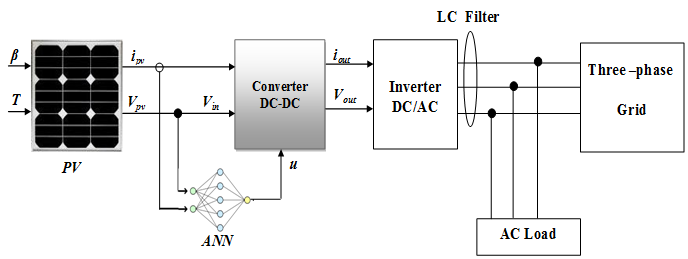Adaptive maximum power point tracking using neural networks for a photovoltaic systems according grid
H. SahraouiHassiba Benbouali University of Chlef, Algeria, https://orcid.org/0000-0002-0827-2559
H. MellahUniversity Akli Mouhand Oulhadj-Bouira, Algeria, https://orcid.org/0000-0003-2841-0530
S. DridUniversity of Batna 2, Algeria, https://orcid.org/0000-0001-8289-7103
L. Chrifi-AlaouiUniversity of Picardie Jules Verne, IUT de l'Aisne, France, https://orcid.org/0000-0002-8302-8409
DOI: https://doi.org/10.20998/2074-272X.2021.5.08
Keywords: grid-connected artificial neural network, adaptive modified perturbation and observation, artificial neural network-maximum power point tracking

Abstract
Introduction. This article deals with the optimization of the energy conversion of a grid-connected photovoltaic system. The novelty is to develop an intelligent maximum power point tracking technique using artificial neural network algorithms. Purpose. Intelligent maximum power point tracking technique is developed in order to improve the photovoltaic system performances under the variations of the temperature and irradiation. Methods. This work is to calculate and follow the maximum power point for a photovoltaic system operating according to the artificial intelligence mechanism is and the latter is used an adaptive modified perturbation and observation maximum power point tracking algorithm based on function sign to generate an specify duty cycle applied to DC-DC converter, where we use the feed forward artificial neural network type trained by Levenberg-Marquardt backpropagation. Results. The photovoltaic system that we chose to simulate and apply this intelligent technique on it is a stand-alone photovoltaic system. According to the results obtained from simulation of the photovoltaic system using adaptive modified perturbation and observation – artificial neural network the efficiency and the quality of the production of energy from photovoltaic is increased. Practical value. The proposed algorithm is validated by a dSPACE DS1104 for different operating conditions. All practice results confirm the effectiveness of our proposed algorithm.
Date de dernière mise à jour : 12/11/2021
Ajouter un commentaire




